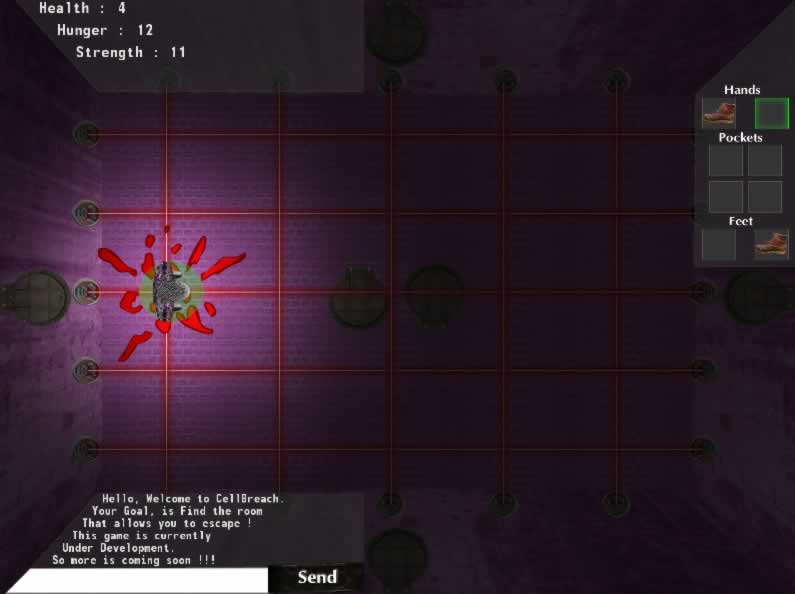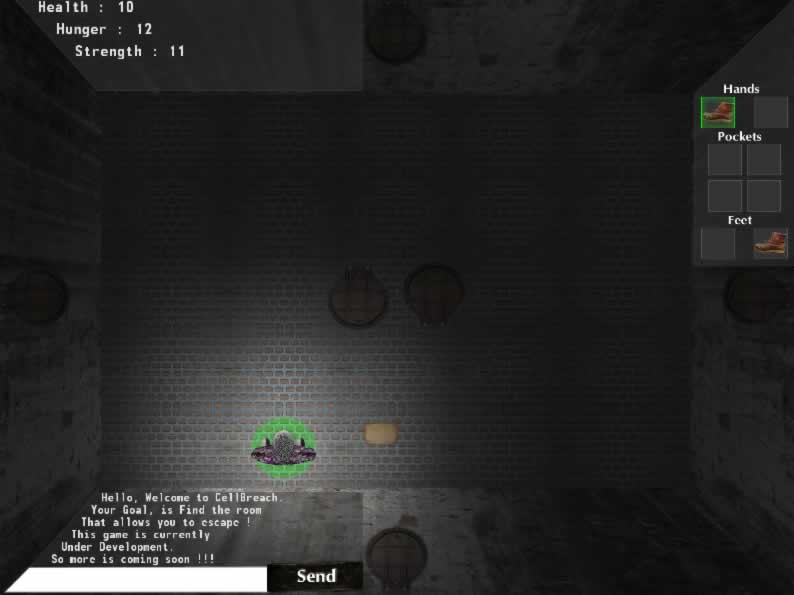CellBreach Mac OS
The maximum version of Mac OS X, OS X, or macOS supported by each G3 and later Mac follows. For complete specs on a particular system, click the name of the Mac. For all Macs that are compatible with a specifc maximum supported version of Mac OS X - courtesy of EveryMac.com's Ultimate Mac Sort - click the OS of interest. Find games for macOS like Friday Night Funkin', Cold Shot, Wrong Floor, Deepest Sword, Dying of Thirst on itch.io, the indie game hosting marketplace.
How to install brew packages based on XCode, Ruby, Homebrew
- Install Homebrew
- Formulas
This tutorial provides a deep dive of Homebrew,a package manager for Mac OSX (MacOS)that’s like other package mangers for Linux:
- Mac OS X & macOS names. As you can see from the list above, with the exception of the first OS X beta, all versions of the Mac operating system from 2001 to 2012 were all named after big cats.
- Note: The headings on this list indicate the Macintosh System bundle names; the bullet points indicate the version of the System File included in that bundle. This is to make it clearer for people searching for specific bundle versions as opposed to System File versions. Finder File versions are not indicated. 1 Classic Mac OS 1.1 Macintosh System Software (0 - 0.3) 1.1.1 System File 1 1.1.2.
- Timestamps and links below!Considering the changes coming to the macOS platform announced at WWDC 2020, I figured it was time to explore what building an ope.
| Distribution | Package Manager | Format | GUI tools |
|---|---|---|---|
| Darwin (macOS) | Homebrew | - | brew |
| Debian, Ubuntu | dpkg | .deb | APT (Advanced Packaging Tool) |
| RedHat, Fedora, openSUSE | RPM | .rpm | Yum, apt4rpm, up2date, urpmi, ZYpp, poldek |
| Slackware | tgz | - | - |
| Arch Linux, Frugalware, DeLi Linux | Pacman | - | - |
| Puppy Linux | PETget | - | - |
| Windows | Chocolatey | - | choco |
Step-by-step instructions are provided here to install Homebrew itselfand then install Homebrew packages based on the name of formulae specified for installationin a command such as:
brew install wget

DEFINITION: A formula provides instructions on how to install packages andtheir dependencies, such as where to find tar.gzip files for download.
Brew installs packages in its own Cellar directory (folder)and adds symlinks to the /usr/local folder.
Homebrew is the newest and most popular package utility on OSX.
Homebrew’s web page is at http://brew.sh
Alternatives to Homebrew
Preparations: XCode CLI
Make a full backup of your system right before following these instructions.
Open the App Store to install XCode, Apple’s IDE for developing Swift and Objective-C to run on iPhones and iPads.
PROTIP: Apple’s App Store only installs .app files. So programs invoked from the command line Terminal (such as gcc) need to be installed a different way.
To verify XCode CLI install:
This message means that it’s not installed:
Open a Terminal to install XCode CLI:
If XCode is not already installed, you are prompted to install it:
Installation is to folder: /Library/Developer/CommandLineTools/.
Homebrew requires OS X 10.5+ and the Xcode command line tools.
To download the Command Line Utilities, go to https://developer.apple.com/download/more/and look for your version of “Command Line Tools (macOS 10.14) for XCode 10”, one that doesn’t say “beta”.
Since the El Capitan version of Mac OSX, file permissions in /usr/local have changed,causing error messages such as:
xcrun: error: invalid active developer path (/Library/Developer/CommandLineTools), missing xcrun at: /Library/Developer/CommandLineTools/usr/bin/xcrun
So in a Terminal shell window at any folder:
sudo chown -R :staff /usr/local
Verify installation by getting the version of the GNU Compiler Collection:
gcc --version
You should see something like this (for Mojave):
Install Homebrew
Homebrew makes use of Ruby, which comes with macOS.
Cellbreach Mac Os X
Install Homebrew if you haven’t already.
CAUTION: Don’t press Enter on the Terminal until the Download Software dialog reaches 100%.
Press the Enter key to the message:
Press RETURN to continue or any other key to abort. thenTo proceed, enter the root password, or type Ctrl+C to abort.
NOTE: The download is from
https://github.com/Homebrew/homebrew/HISTORICAL NOTE: Previously, the Homebrew installer was at
https://raw.github.com/Homebrew/homebrew/go/install/Identify where the Homebrew program itself is located:
The response is the brew executable program at:
The “brew” above is a shell script file.
PROTIP: The “/usr/local” is the default specified by the $HOMEBREW_PREFIX enviornment variable.
Identify where the Homebrew program stores packages:
The response:
Update Homebrew itself
Get Homebrew version:
The response (at time of writing):
NOTE: Homebrew is open-sourced at
https://github.com/Homebrew/homebrew/blob/master/share/doc/homebrew/Common-Issues.mdTo update Homebrew itself and its formulas:
brew update
brew updateYes, run it twice to make sure all dependencies took.
Each run can take several minutes.
Formulas
Popular formulas
wget
iterm2

htop
Cellbreach Mac Os Download
geoip
nmap
Search for a formula to install
Use an internet browser (such as Google Chrome)to view formula defined in
http://braumeister.org provides recent activity.
Install formula
Install the wget command-line utility by formula name (for example, wget):
brew install wget
This installs to folder /usr/local/bin/wget.
See Tips & Tricks on how to use proxy, remove the beer mug emoji, highlighting within editors, etc.
How many?
Get a count of kegs, how many files, and the disk space they take:
A sample response:
Where did it go?
List where .tar.gz “bottle” files are downloaded into from the internet:
DEFINITION: A “Bottle” is a pre-built binary Keg used for installation instead of building from source.It can be unpacked.
The response includes your user name, which enablesHomebrew to work without using sudo (elevation to root).
The equivalent of the above is:
List bottles downloaded:
Examples of responses:
List brew formulas installed:
ls /usr/local/Cellar
brew list
brew lsThe alternative commands above all do the same thing of the same folder,for example:
There is no response if no brew package has been installed.
See one level below one of the above folders for a specific formula,such as openssl:
It is usually a version number, such as:
DEFINITION: A “Keg” is the installation prefix of a formula, such as:
Packages
List brew package .rb (Ruby language) files installed:
The response is a long list.
List brew package folders:
brew search
The response is a long list.
Troubleshoot Homebrew
Different ways to install weget.
The above is one of several ways to install the wget command-line utility.
One way is to install Apple’s Xcode.
Test wget operating:
cd ~/Downloads
wget http://ftp.gnu.org/gnu/wget/wget-1.15.tar.gzVerify brew installation:
brew doctor
If you see this message at the top of messages returned:
The above may occur if curl and nodejs were installed without using homebrew.
Remove them before installing node and curl using Homebrew:
Create symlinks to installations performed manually in Cellar. This allows you to have the flexibility to install things on your own but still have those participate as dependencies in homebrew formulas.
First, see what exactly will be overwritten, without actually doing it:
The response is:
“Keg-only” refers to a formula installed only into the Cellar and not linked into /usr/local, which means most tools will not find it. This is to avoid conflicting with the system version of the same package.
Alternately, if aswcli is specified for dry-run, the response is:
brew link
NOTE: Homebrew installs to the Cellar it then symlinks some of the installation into /usr/local so that other programs can see what’s going on.
A symlink to the active version of a Keg is called an “opt prefix”.
List where a link goes:
ls -l $(which wget)
Prune symlinks
If you see this message:
A sample response:
List formula (package definitions):
brew edit $FORMULA
The above command brings you to your default text editor (vim or whatever is specified in the $EDITOR variable).
Type :q to quit out.
Upgrade brew formulas
List brew packages that are obsolete:
brew outdated
To stop a specific package from being updated/upgraded,pin it:
brew pin $FORMULA
$FORMULA is ???
To allow that formulae to update again, unpin it.
Download and update ALL software packages installed:
brew upgrade
To see which files would be removed as no longer needed:
brew cleanup -n
No response if there is nothing to clean. Otherwise, example:
To really remove all files no longer needed:
brew cleanup
A sample response:
Remove/Uninstalll
PROTIP: Before deleting, identify its dependencies. For example:
Two delete commands does the same: Additional flags: `–force` or `-f` forcibly removes all versions of that package. `–ignore-dependencies` ignore dependencies for the formula when uninstalling the designated package, which may cause other brews to no longer work correctly.## Tap #Brew tap adds repos not in the Homebrew master repofrom inside a larger package.https://github.com/Homebrew/brew/blob/master/docs/brew-tap.mdsays tap adds to the list of formulae that brew tracks, updates, and installs from.0. List brew tap packages already installed: 0. Install the ip tool included with iproute2 on Linux: The command specififies the account and repo in GitHub, as inCellbreach Mac Os Catalina
https://github.com/brona/iproute2mac or https://superuser.com/questions/687310/ip-command-in-mac-os-x-terminal 0. Try it (instead of ifconfig): 0. Remove a tap: ## Brew Cask Install #Homebrew cask extends homebrew and brings its elegance, simplicity, and speed to MacOS (OS X) GUI applications and large binaries.https://caskroom.github.ioWith Cask, you can skip the long URLs, the 'To install, drag this icon…', and manually deleting installer files.0. Temporarily set the permissions on /usr/local: 0. Install brew cask: Applications are kept in their Caskroom under /opt and symblinked to $HOME/Applications from https://github.com/caskroom/homebrew-cask0. https://caskroom.github.io, the home page, said there are 3,197 casks as of June 5, 2016. QUESTION: Is there a graph of growth in cask counts over time?0. Install the cask extension to Homebrew: Alternately: 0. Search for a cask by name, in website is where casks are obtained: https://github.com/caskroom/homebrew-cask/search?utf8=✓ Alternately, run a search command. This example searches for 'yo': PROTIP: One should see the cask definition before using it. I would be suspicious of casks with sparse information. The safe way to get the homepage URL of the programmer is from here (don't Google it and end up at a rogue site).0. Look at some cask definitions: https://github.com/caskroom/homebrew-cask/blob/master/Casks/google-chrome.rb is a sample cask definition:0. Install the cask: brew cask install google-chrome Cask downloads then moves the app to the ~/Applications folder, so it can be opened this way:0. Open the installed cask from Terminal: 0. Installing with cask enables you to cleanup: ### Error prevention If you get an error about 'permissions denied':0. Create a Caskroom folder 0. Edit the .bash_profile 0. Add this line: QUESTION: The use of --caskroom is deprecated?0. Save the file.0. Restart the terminal. ## GUI for Homebrew packageshttps://www.cakebrew.com/ is a GUI to help manage Homebrew packages: ## Analytics offHomebrew now defaults to retrieving behavioral analytics tracking. Although anonymized, you may not want to participate in that. To disable the extra network traffic: ## Debian apt-getDownload Fink commander Fink Installer.pkg fromhttp://finkcommander.sourceforge.net/help/install.phpThis explains: Fink stores data in the directory “/sw” by default. This goes against the Filesystem Hierarchy Standard’s recommendation to use “/usr/local”. Within Fink’s directory, a FHS-like layout (/sw/bin, /sw/include, /sw/lib, etc.) is used.## Documentation #0. For more documentation on brew, look here and: man brew ## Social media #Social media from brew's readme: * @MacHomebrew on Twitter * IRC freenode.net#machomebrew * Email homebrew-discuss@googlegroups.com * Read archive of emails at https://groups.google.com/forum/#!forum/homebrew-discuss## More on OSXThis is one of a series on Mac OSX:* [MacOS Hardware and accessories](/apple-macbook-hardware/)* [MacOS Boot-up](/macos-bootup/)* [MacOS Versions](/apple-mac-osx-versions/)* [MacOS Terminal Tips and Tricks](/mac-osx-terminal/)* [MacOS Find (files and text in files)](/find/)* [MacOS Keyboard tricks](/apple-mac-osx-keyboard/)* [Text editors and IDEs on MacOS](/text-editors/)* [Command-line utilities for MacOS](/mac-utilities/)* [MacOS Setup automation](/ansible-mac-osx-setup/)* [MacOS Homebrew installers](/macos-homebrew/)* [Task Runners Grunt and Gulp](/task-runners/)* [Printing from macOS or Linux](/printing/)* [Manage Disk Space on MacOS](/mac-diskspace/)* [Data Backups on MacOS](/apple-mac-osx-backup/)* [Screen capture on MacOS](/screen-capture-apple-mac-osx/)* [Ports open](/ports-open/)* [Applications on MacOS](/apple-mac-osx-apps/)* [1password on MacOS](/1password/)* [MacOS iPhone integration](/mac-iphone/)* [Windows on Apple MacOS](/windows-on-apple-mac-osx/)* [Packer create Vagrant Windows image](/packer/)* [Remote into Windows](/rdp/)* [Python on MacOS](/python-install/)* [Maven on MacOS](/maven-on-macos/)* [Ruby on MacOS](/ruby-on-apple-mac-osx/)* [Java on MacOS](/java-on-apple-mac-osx/)* [Node on MacOS installation](/node-osx-install/)* [PHP on MacOS](/php-on-apple-mac-osx/)* [Scala ecosystem](/scala-ecosystem/)Please enable JavaScript to view the comments powered by Disqus.